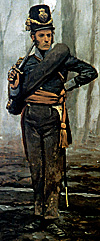 Of the many acrimonious debates which have emerged in the aftermath of the battle of Waterloo, none has hurt national pride as much as accusations of cowardice regarding the performance of the Dutch-Belgian troops serving under the Duke of Wellington. Using newly translated Dutch and Belgian primary material, and statistical analysis, the facts surrounding the behavior of Bijlandt's (or Bylandt's) Brigade early on the afternoon of that fateful day can now be separated from long-held myths.
Of the many acrimonious debates which have emerged in the aftermath of the battle of Waterloo, none has hurt national pride as much as accusations of cowardice regarding the performance of the Dutch-Belgian troops serving under the Duke of Wellington. Using newly translated Dutch and Belgian primary material, and statistical analysis, the facts surrounding the behavior of Bijlandt's (or Bylandt's) Brigade early on the afternoon of that fateful day can now be separated from long-held myths.
It is rather surprising to note that, after almost 200 years, the conduct of Major General W. F. Graf van Bijlandt's brigade on 18 June 1815 is still a matter of rancorous debate, particularly for Dutch and Belgian historians. Did the brigade run away as most British sources claim? Was this withdrawal exonerated by the brigade's exposed deployment before the heavy masses of French guns and infantry? What do the casualties suffered by Bijlandt's men indicate about their performance?
At right: 7th (Belgian) Line Battalion officer. © Keith Rocco.
These questions need to be addressed in a convincing way. No doubt, the fact that very few English-speaking historians read Dutch has created a void wherein the other side of the story has been ignored. The following article focuses on the accounts of the Dutch-Belgian participants in the 1815 campaign.
More Cowards at Waterloo?
Introduction
The United Kingdom of the Netherlands Is Created
15 June: The French Advance
16 June: First Experience of Battle
17-18 June: Retreat to Waterloo and Infamy
Response to British Allegations by Renard
Combat Losses: Bijlandt and Allied (slow: 316K)
Back to Table of Contents -- Napoleon #16
Back to Napoleon List of Issues
Back to MagWeb Master Magazine List
© Copyright 2001 by Napoleon LLC.
This article appears in MagWeb (Magazine Web) on the Internet World Wide Web.
The full text and graphics from other military history magazines and gaming magazines are available at http://www.magweb.com
Order Napoleon magazine direct